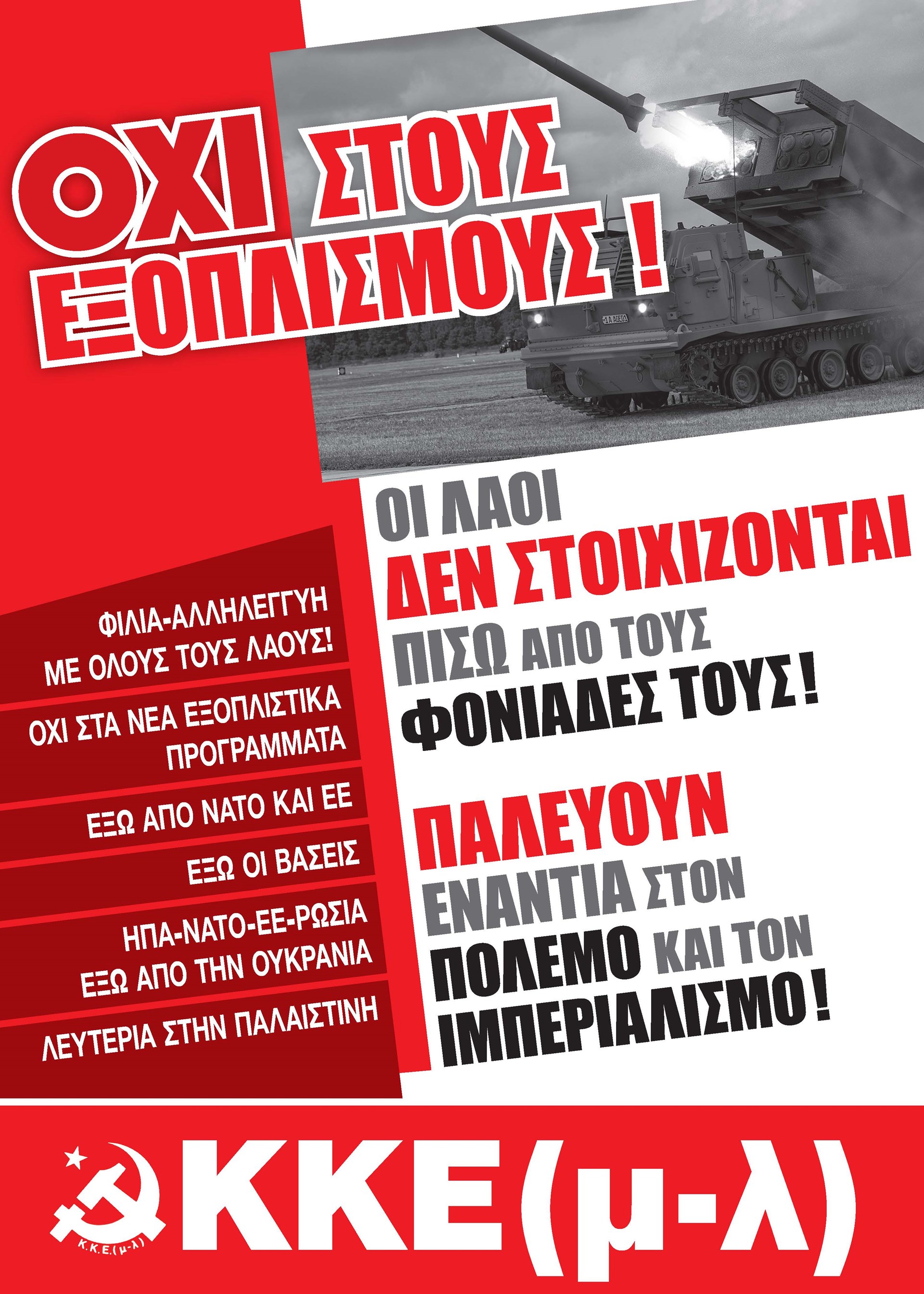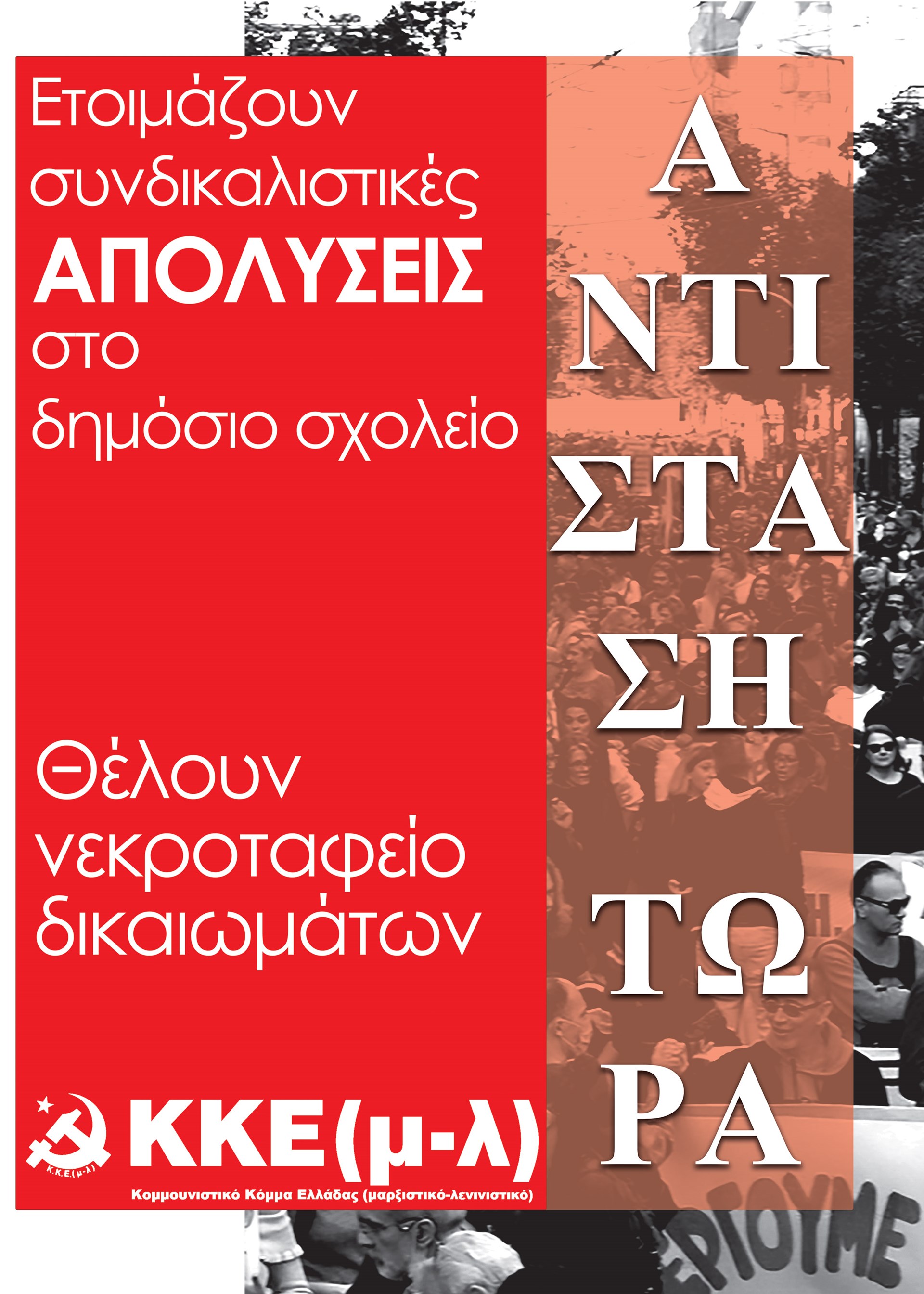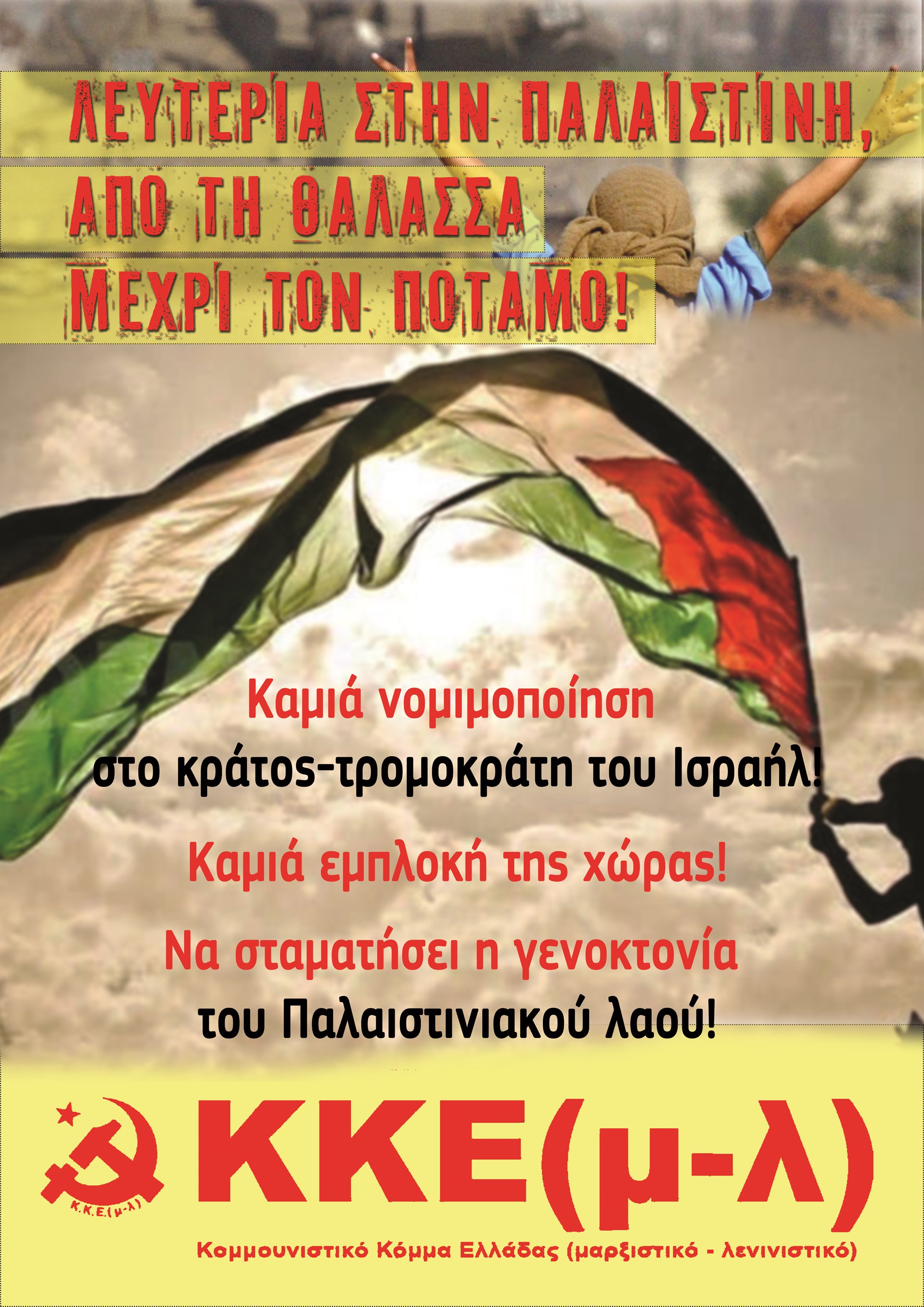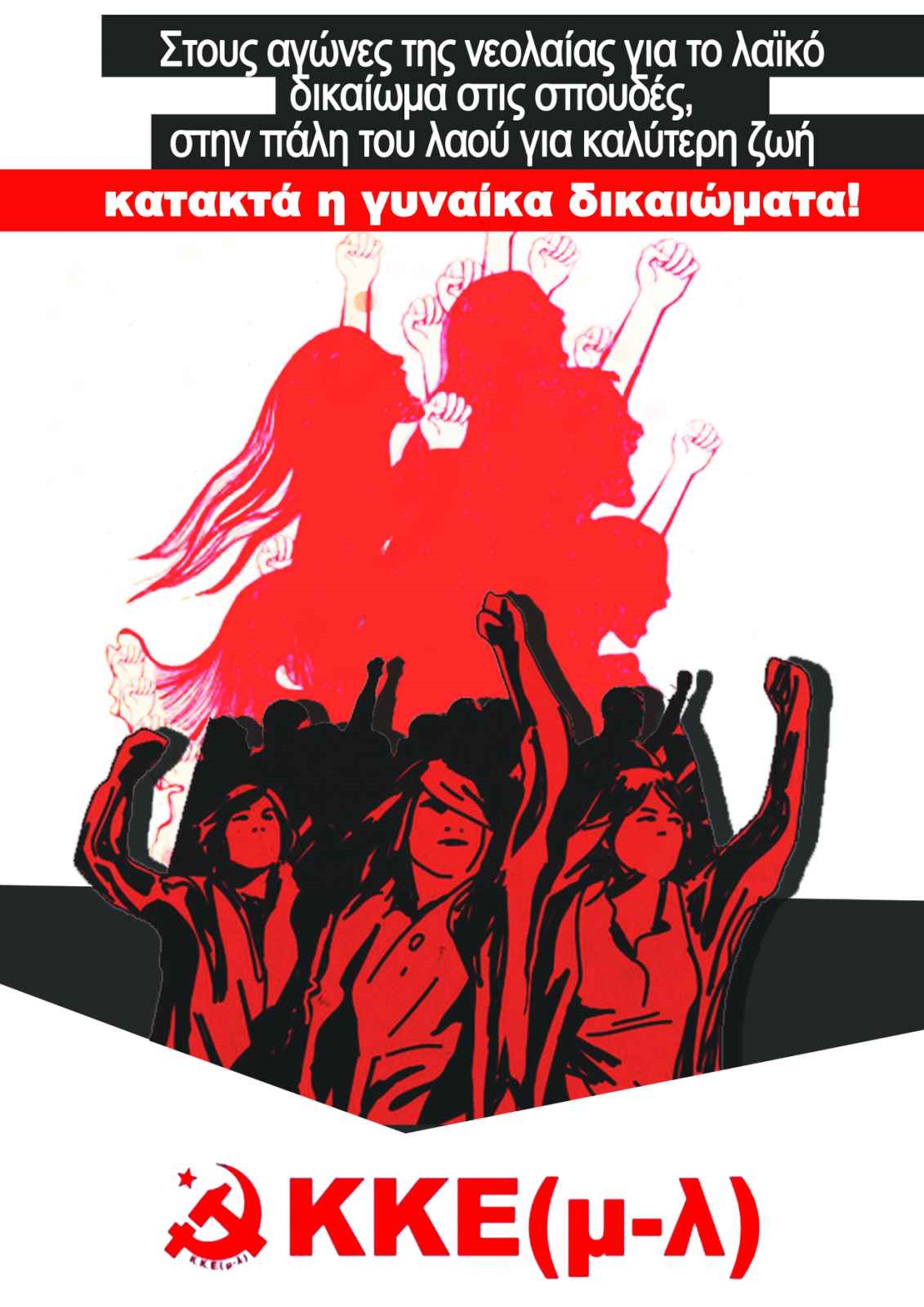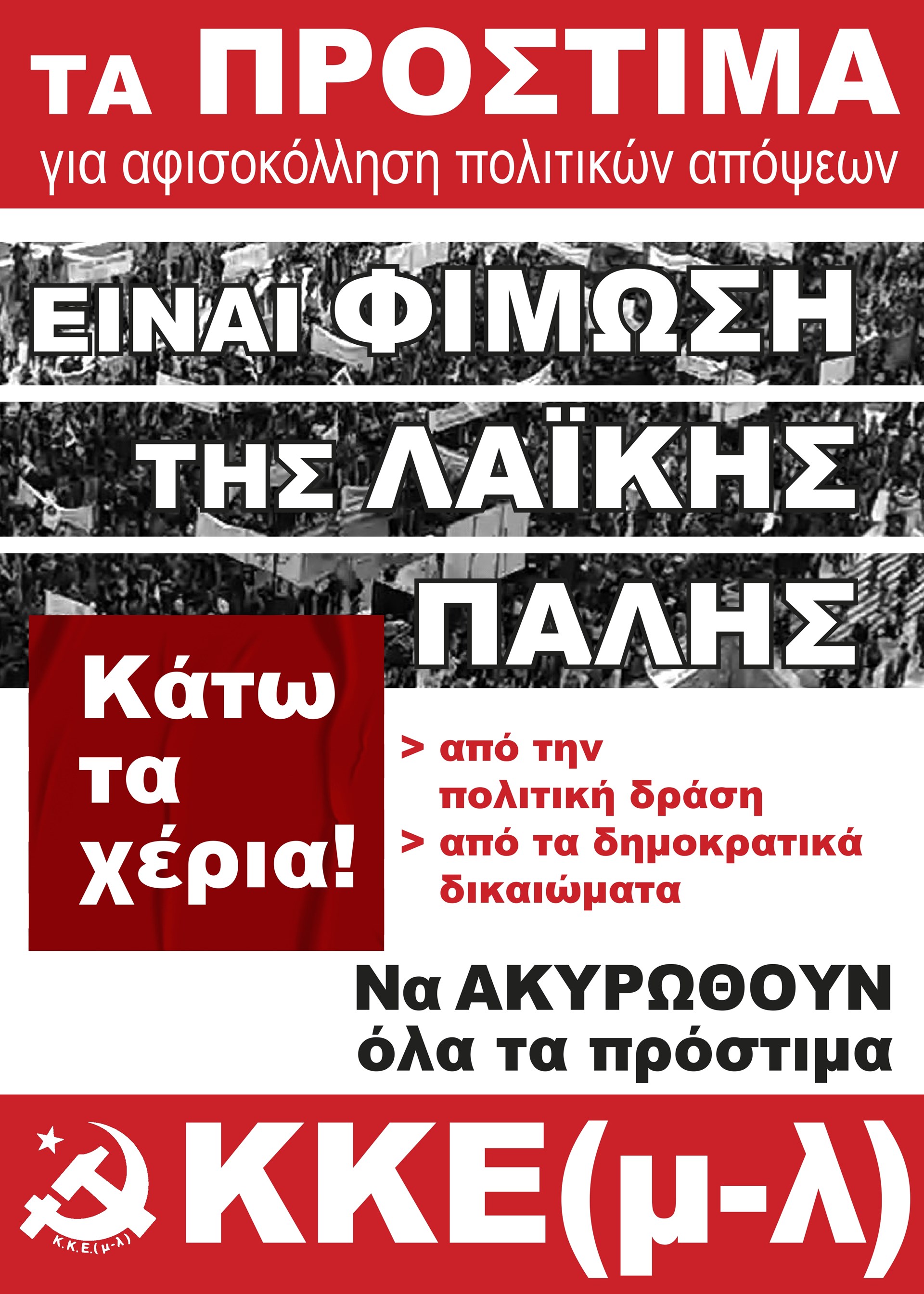Presentation of CPG(m-l) in the International Meeting that took place in Athens on 4 and 5 of November.
Topic of Discussion:
Capitalist restoration: causes – effects – the answers of the movement.
IN ORDER TO GIVE ANSWERS TO THE CRUCIAL QUESTIONS OF THE RESTORATION OF CAPITALISM
A.THE POINT OF VIEW
Why is it necessary to look into the crucial issues concerning the restoration of capitalism that ultimately prevailed at the former socialist countries? The answer lies in a number of processes that are interdependent and that the previous one is contained in the next one:
According to this approach, there are no «pure and clear» socialist revolutions, but revolutions that occur at the specific historical time, take shape and substance by confronting rather than avoiding reality in the critical and decisive ramifications of the historical conjuncture.
Socialist revolutions – on their way, would have to face a variety of inertias of centuries. But we know that the stabilization of bourgeois sovereignty «demanded» half a century of historical overturns and movements. Ultimately, the consolidation of bourgeois sovereignty was the replacement of a class system (feudalism) with another (capitalism) rather than the raid that would ensure a definitive non-return to any class society. Towards such a great historical course, 70-80 years of the socialist attempt is a very little historical time. In this «little» and condensed historical time, however, jumps forward were accomplished that cannot be encountered and counted with the usual – up to 1917 – human and historical scale. This is a historical fact and it’s not diminished by «so many other» questions, inadequacies and gaps inherited to today’s Communists by the working class raiding in the skies and the creation of the first working or working-agricultural state system. Any other reference to either utopian desires or to the opinions of the lost «earth paradise» that teachers and priests used to promise to their believers is out of the question. On the contrary, it leads to accept the supposedly objective and irreversible of the restoration of capitalism.
And to say it even more simply – given the obligatory choices for the revolutionary leaderships imposed by the unequal class correlation – there is a need to investigate » what could» be done to avoid restoration of capitalism. Furthermore «this which could have be done» why eventually wasn’t given the necessary and requisite dimensions to prevent such a regression.
Or at least, even if they didn’t prevent them why didn’t they leave as a visible historical «trace» those important resistances or consignments which the new «raid in the sky» could step on.Why should we look for these «traces» and consignments pretty hard today? This is also a question among many others.
B.CHAPTERS OF THE CONVERSATION
Continuing in the same context of reference, and based on the perspective already exposed, one more question that could be added is that the restoration of capitalism was manifested not in the less … favorable to socialist development time and place in terms of correlations but the opposite. At least with an external-quantitative look…
After Second World War the power of the socialist camp was more secure in relation to the pre-war period…The countries that developed socialism in general terms (but also in each country) had managed to overcome the disaster of war, the economic indicators had risen, as well as their living standard, when the first appearance of the economic crisis began to become visible in the capitalist world alongside the sharpening of intra-imperialist contrasts.From the point of view of defense, imperialist nuclear blackmail – especially after the Korean War – still existed, and also China was already included in the nuclear countries. The glory of the socialist countries in the anti-colonial movement opened new fields of widening socialist and communist influence while despite the cleansing operation of McCarthyism in Western imperialist countries – except the USA – there still existed large Communist parties (France, Italy).The bourgeoisies themselves in the imperialist metropolises tried to rescue the bourgeois sovereignty by copying elements of the «welfare state» of the «iron curtain» as Churchill himself had said he himself discovered both … terms.
The restoration of capitalism happens «paradoxically» during this period of time in the critical decade of the `50.
This paradox has some explanations.
One of these is about what the Greek Marxist-Leninist Yannis Hondzeas said that the communication lines of the communist movement had been diverged in the capitalist-imperialist world that the connection with the «center» had been lost. But what happened to the «center» itself?
In the 1950s – in a positive way – the accumulation of economic, social, military and other potentials of the countries that constructed socialism not only occurs but at the same time a series of unresolved ideological and political issues are accumulated that torture the center and the edges of the communist movement.
These issues concern either the incumbent situations within the frameworks of socialist development and the relations between communist parties (largely influenced by the statehood of the great power), or they are negative heritage of actions, decisions and choices of the previous period.
Characteristics, mentalities and attitudes that the War and the participation of communists in it, as well as the creation of new socialist states after its end enlarged, expanded and intensified. These issues form the fields of a debate that should begin in order to confront the new enlarged possibilities and the accumulated problems opened up by the expansion of the socialistic world against the capitalistic one, and not the … absorption by the capitalist-imperialist world that was finally imposed as a choice with the counter-revolutionary overthrow.
It is true that Stalin attempts in his «Economic Problems of Socialism» in 1952 to define the disputed issues of socialist development into the relevant discussion that had begun in the USSR.
It opposes a double front to both, first to that part of intelligentsia who consider that, in the absence of the working class and «in its name», it will be able to rationalize and «hitch up» economic laws through state planning …second to that part of the executives of state-owned enterprises who demand to «lessen» the socialist controls, and to give speech and space to capitalist financial management practices (or «market»). But this discussion is limited to the “economists” fields or even to the «executives» fields and does not touch the wide range of workers. In addition, according to the Chinese Maoist criticism, Stalin’s intervention, although in the right direction of defending socialism, is not related to the discussion of changes to be made to the so-called cultural superstructure and ideology not, of course, cut off, but in a dialectical effect with the transformations that motivated the productive relationships.Socialist transformations in productive relations are the «key» of all crucial revolutionary transformations of the socialist transition period. Stalin also recognizes that.
Of course, regarding that period, we could support that the late rupture with revisionism by the Chinese side also delays the opening of this discussion, with all the consequences that this will cause in this crucial time ramification (until 1957 The CPC and the PLA participate in the world conferences of communist parties, and Mao’s presence indeed gives them an increased prestige that they have already won over the other communist parties).
With certainty we can say that the emergence of a New Bourgeoisie through the lines of the party and the state, or better of the party-state, was not only a process of a coup and of military nature (it also had such features). Khrushchev’s coup was the result of the even greater removal of the working class from the track of socialist construction, the gradual loss of its own responsibility in how socialism would be constructed throughout all the previous period. Therefore the gradual removal of its own «imprint» and its own physiognomy from this process. Simultaneously and alongside the responsibility of the working class, detaches initially the body of «working-class intelligentsia» (as Stalin characterized it) that the socialist construction itself has produced and is credited as its own success.
But the successes of socialism are in a sense the other side of its… failure since we have here the application of the law of dialectics that orders under specific circumstances positive elements to become their opposite. How, with which ways and from which point on this «body» of state administratives, economic technocrats, military officers and party officials, though with worker-peasant origins, gains consciousness of a particular strata and moves as one is an issue that must be studied. It is confirmed from the results of course that it acted finally with the counter revolution overthrow as such! Therefore it was the «red» intelligentsia itself, the body out of the body of the working class that overthrew finally the… red and seized power from the class that it came from.
4. The limited perception about the role, the transformations and the forms of class struggle during the socialist construction.
For the USSR and the countries of East Europe by extension significant part in deactivating the class, ideological and political reflexes of the communists played the limited perception that saw the class struggle to be carried out only between the working class and the remains of the exploiting classes. This is an interpretative distortion of the Leninist view. That didn’t see the existence competing contradictions during the transitional socialist period, the promotion of bourgeois elements within the party, the economy, the society and the state at the base of these contradictions. The most characteristic outcome of this limited perception for the class struggle (that is charged to the Stalinist leadership that accepted it) is the position of the 1936 constitution that «abolishes» class struggle as a moving force with the so-called «moral-politic unity» of the soviet society. In that period especially that the class struggle in USSR intensified, while a little later the main proposer of this position of the constitution, Bukharin, will be sent to the firing squad! This apparent contradiction is a very characteristic example of how complex the issues that had to be answered had started to become even though significant role at closing them played for that period the need to create a concrete front against the upcoming war. The ideological corrections that have been attempted after the War didn’t touch this fundamental false position and –as it has been said- was limited in a circle of cadres
On the other hand someone distrustful could claim that the recognition of the class struggle and the competing contradictions in socialism didn’t save the Chinese revolution. So it is. But all the historical movements of the working class can’t be judged with the method of the vulgar efficiency. Because the findings and declarations of the Chinese communists gave the potential to carry out a big scale class confrontation (Cultural Revolution) that even though it too didn’t end victorious for the proletarian left, at least gave an exceptional body and material if not of answers at least of questions that need today to be studied -initially- about the open matter of the ability of capitalist restoration during the socialist transformation of society.
It is true that in China, was declared openly the probability of a bourgeois restoration and negative outcome of class struggle for the working class. The struggle of two lines was highlighted, the capitalist and the socialist way in the entire duration of the transition.
In that sense Leninism and its position for the continuation of class struggle in socialism was restored in a higher level and that of course has nothing to do and is in direct confrontation, with the «restoration» – caricature that the Khrushchev’s revisionists tried only for burying Leninism and Marxism.
Ιn relation to the above it is an even more limited perception for the contradictions in socialism that they don’t see them as one internal procedure of the soviet society itself but as a provoked work of the capitalist encirclement.
C. THE FIELDS OF CONVERSATION ABOUT THE RESTORATION
1 Content and forms of class struggle in socialism.
To the extent that the class struggle is continued during the whole transitional period to communism which was called »socialism», the bases, the content and the forms that it takes must be defined.
The controversy concerns the content and the forms that the relations of production will take and how they will transform towards a communist direction. This is the first and most decisive field of controversy between the bourgeois and the proletarian line. It was proved in relation to the above that the educational system of socialism can be another big field of controversy. Τhe payment system (thus distribution) which is still affected from bourgeois law, the effort to overcome the economic requirements that bring the function of the law of value within socialism – even if it is »under restriction»- the existence of different systems of ownership are too fields that feed contradictions that manifest the struggle between the two lines.
The issue is that in the USSR this controversy -as mentioned – was confined in a small circle, was not ideologized sufficiently (as in China where the issue of »two roads» was openly put) and of course the working masses where not mobilized, this controversy was not owned by the masses.
On the other hand the Chinese experience has shown -with all the unanswered questions that left behind and are mainly connected with the part of the party in socialism – that it is necessary for the victorious outcome of the controversy, the formation of a collective leadership that defends firmly, consistently and constantly the proletarian line. The personality cult phenomena that were repeated to a greater extent compared to Stalin, with the multiple references to the figure of Mao, the unacceptable imperial designation of a »heir», the way that the »Gang of Four » was set aside, overturn and eliminated etc. broached dramatically that issue. That in the final analysis constitutes a problem for all the proletarian revolutions, since the new bourgeois elements and the overturn efforts manifest shortly after the physical withdrawal from life of the proletarian leaders. (USSR, China, Albania). Or they manifest with the »necrosis» and »freezing » of the revolutionary procedure and the silent transformation in a kind of state capitalism with socialist past and references (e.g. Cuba or Korea)
2. The issue of the relations between the party and state
Another field that created material and political conditions for the bourgeois restoration is the relation of party – state in the procedure of the socialist transformation of the society.
Being the only political party that guided the revolutionary procedure (therefore the only party of the internal political life ) the Bolshevik party (and the CPC) went through several transformations at various times and periods that the class struggle intensified in the soviet society. Its identification with the state constituted a negative factor, because the new soviet regime identifying the state – administrative functions with those of the party deprived from the working class its political tool. Furthermore created a kind of established authority, a step of arrivism for the new bourgeois elements that disguised in communists in order to continue to » remain in the matters » Many of the suppressing exaggerations of the state mechanisms, especially at the period of collectivization, came from the actions of such elements. Without, of course, misestimating that the use itself of the state mechanisms and the extend of state suppression create by themselves conditions of »removal of those mechanisms from society » and »reproduction inside them bourgeois authoritarian relations and terms ».
3. State of the dictatorship of the proletariat and the dictatorship of the proletariat.
This is a subtle distinction but an essential one.
Without misestimating that the socialist state must be well armed and ready to come up against the capitalist encirclement and to be able to respond effectively with organized violence against the violence of the imperialists, as V. Samaras writes, it must tend to be »something of a state».
That means that next to the »state per se» (the mechanisms of inner and outer suppress) there is a need of more wide terms to be created, without obstacles, free and essential participation of working and popular masses in the politic and social life. In that sense the proletarian democracy which is the … other name of the dictatorship of the proletariat, let’s not forget, is wider than the state of the proletarian democracy. The identification of the party with the state is a synonym of the identification of the dictatorship of the proletariat with its state and the false perception that the latter one means a centrally planned, concentrated and constantly increasing administrative and state mechanism.
The experience of authority »three in one» that was tested during the Cultural Revolution, the ongoing movements in society, culture, education, economy underline this subtle but essential distinction that making it happen is obviously not one of the easiest things in the world. Because these movements necessarily deconstruct, therefore weaken institutions and mechanisms that tend to consolidate in the socialist society too. Therefore they weaken the state authority of the proletariat -out of necessity- at the same time that they try to give wider and deeper content to the overall presence and specific weight of the proletariat in society, economy, and culture! It is another dialectic contradiction that handling and solving, demand another kind of »mastery» from the proletarian leaderships. Here of course is needed a reserve of positive and negative experience that of course the soviet leadership did not have. There was only the short historical example of the Commune – when the construction of the first workers state in the world started.
4. The issue of the party in the socialist transformation.
Related to the above is the »autonomous» issue of the role of the party in socialism. But the issue of the role of the party in socialism is one of the less »classified» and answered issues for this transisonal period. Stretching a bit the consideration on the state of the dictatorship the proletariat we would wonder proportionally »how much state and how much party» is necessary for socialism or »how much state for … how much party». In any case we must examine beyond the quantitative correlations – that has their value- of what kind of party are we talking about in socialism?
Here we must emphasize that the one party choice was not that what the Bolsheviks or the Chinese communists had in mind from the beginning. It was enforced by class struggle itself and the attitude of the other left wing tensions towards the soviet authority and the overcompensation of the national – democratic goals of the other parties by the CPC during the new democratic revolution in the case of China.
The answer is not in multipartyism or the freedom of the bourgeoisie to have political representatives, much more the issue that we bring is not connected with the legalization of wings and factions.
Since the existence of a party essentially means no party (the political life demands at least some different poles and parties to exist as such) there is the issue of which must be the role of the communist party in socialism. And how will the political life in socialism be.
And because we do not suffer from pseudo-democratic hypocritical syndromes of the bourgeois what interests us here is:
How the communist party will be able to »incite» criticism from below and participation of the masses in the political and social life? How must the political life be in socialism? We come again at the issues of the relations of the dictatorship of the proletariat with the state of the dictatorship of the proletariat as sited above.
That is how the communist party from a -sole- government party will transform in a sense, in a non-establishment, political entity that as a collective organizer will organize and the guide the widening, free, unobstructed participation of the working class to the institutions of the proletarian democracy and the movements of the socialist transformation of the society.
Here there are no complete answers. Even the Cultural Revolution that affected and pointed out this issue did not answer it. It is certain that the procedure of the bourgeois restoration helped significantly – and in fact was one of the material terms – the incorporation of the revolutionary communist party in the structures of state authority. In fact the Brezhnev or the Chinese example proved that the party itself – lacking of other mechanisms- can be transformed in… an excellent central mechanism of control that imposes the ruthms and means of the bourgeois – capitalist restoration. And the socialist state can be transformed in a social-fascist one.
5. About the issue of violence. Revolutionary violence and state mechanisms in socialism.
Due to the fact that the issues that are examined with the epicenter on the capitalist restoration are connected with each other, the issue of enforcing revolutionary violence in socialism is connected with what has been mentioned above (relations between party-state-mechanisms of authority). Proportionally the revolutionary violence during the socialist transformation of the society is broader than the violence that force with exclusivity–we could say- the state/repressive mechanisms. And isn’t identified with them.
Revolutionary violence is for example the confiscation of the big landowner’s fortunes, revolutionary violence is to demand and force dazibaos to be posted, that the revisionist leaders and professors forbid, revolutionary violence is e.g. to send the Red Guards at the theocratic Tibet, the campaign for collectivization and the violent clashes with the kulaks etc.
The dictatorship of the proletariat isn’t going to –and must not- expropriate for itself the right to apply the revolutionary violence in the whole duration of the transitional socialist period. However, the violence that is forced by the state – repressive mechanisms of the dictatorship of the proletariat, from the state, is a different thing. Not only because it incorporates legal clauses, rules and penalties and much more executions. But because if the revolutionary violence of the dictatorship of the proletariat is forced MAINLY through the state mechanisms, we have two very serious negative effects concerning the long term communist goal which is the necrosis of the state: the one effect is the autonomous –from the rest of the society- of the state repressive- penal mechanisms. The other -more serious- effect is the fact that the bourgeois elements that are crushed- insofar they are- and repressed temporarily or even executed as physical entities from the state mechanisms of violence are in essence reproduced politically inside the state mechanisms. Because they “feed” from the authoritative relations that are formed and established there…
6. The issue of ideologizing forced choices.
As mentioned the socialist revolutions did not manifest in a… vacuum but specific though rarely «normal» conditions of «temperature and pressure». That, many times forced decisions, measures and choices that were not compatible not only with the long-term but with the medium-term goals of the socialist construction. This kind of decisions for example were the measures of requisition of the food and means at the period of the «war communism» or on the opposite the measures of «state capitalism» of the period of New Economic Policy period, we can moreover add the «rush» of the fast industrialization and collectivism before the upcoming War. At the same time, the militarization of the economy, the reinstatement of the military hierarchy or much more the purges of the military executives when the efforts for a military coup were revealed (Tukhachevsky case etc.) etc.
In the same canvas we can add that this kind of retreats were accompanied with practices , mentalities and behaviors and generally «established situations» that were characterized more by the bourgeois culture and ideology. For example the behavior of a big state power in the relations with the rest communist parties. Naturally these imperial beliefs – the annexation of the Baltic countries after the war can be included in them- was the reflection of the gradual occupation of power and the centers of the communist movement from that «body» that a later will overturn the socialist direction.
What was required at the period before the War, was all the forced choices that brought this negative mark since they could not be avoided, at least with full consciousness to be «theoretically undermined» and not oppositely theoritisized and justified in every circumstance and much more not to be generalized. Which means that we can say that in that point there is an aberration from the Leninist view that communists must dissociate themselves theoretically and not to be identified with their, on occasion or on circumstance political choices.
On the occasion after the War, the ideological front is expanded because there was a need to open all the issues, as has already been said. The term Stalinist before the Khrushchev coup, of course was connected with any heroic, vanguard, giving AND bold that existed in history until today. A kind of «de-Stalinization» of course was necessary from the… left, meaning a withdrawal of the weight, distortions and mistakes of the Stalin period. However what was finally imposed was the Khrushchev de-Stalinization and in its name the anticommunism of the right wing revisionism. All that that wasn’t dared by the proletarian left was tried by the revisionist right, in the exact opposite way. Overstating the weaknesses and distortions of the Stalinist era in which the members of the revisionist leadership had exceled and distinguished since in that ground of these distortions the bourgeois restoration «blossomed».
Summing up
The noting of the fields and the points of the discussion about the capitalist restoration is a discussion that should have started…yesterday.
From our side this short presentation does not have at the character of a smug projection of a finished and complete approach. On the contrary, it underlines the big and torturous way that the communists of today have to walk in order to give more complete, all round and convincing answers to this big issue.
In fact many aspects have not yet been examined.
Moreover apart from the historic experience, there is an «absence» of experience of the socialist construction at countries besides USSR and China.
Coming back to the beginning and trying to reverse the critique that we ourselves make to those how consider the capitalist restoration as an objective and -expected- development we can say something that might surprise:
Maybe it was «historically objective» for this painful regression to exist. Maybe in the way to communism it was necessary for this accumulation of negative experience that presses unbearably, to transform to its opposite. Let us not forget that when Marx writes about the proletarian revolutions of his time he says that they scorn their first failures, that they come to themselves, that they self-mock and try again and again until they make impossible the return to the capitalist barbarity.
It is known from the nature at least that only the big trees have a heavy «shadow».
The attempt to construct a society without exploitation from one a human to another is a tree that has branches as deep in the future and as heavy as the shadow of the society that we try today to interpret and explain.
